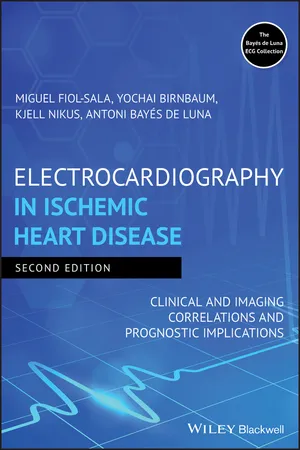
Electrocardiography in Ischemic Heart Disease
Clinical and Imaging Correlations and Prognostic Implications
- English
- ePUB (mobile friendly)
- Available on iOS & Android
Electrocardiography in Ischemic Heart Disease
Clinical and Imaging Correlations and Prognostic Implications
About this book
A fresh assessment of ischemic electrocardiography, its prognostic correlations, and the concepts and principles that underlie its use
The electrocardiogram (ECG) is integral to the accurate diagnosis and optimal management of patients with ischemic heart disease. Picking up a wide range of indicators, it provides valuable prognostic data to cardiologists and emergency medicine specialists for whom ECG readings are a trusted and everyday resource. Electrocardiography in Ischemic Heart Disease is designed to help enhance such clinicians' understanding of ECG recordings and their relationship to anatomical patterns of myocardial ischemia, thereby facilitating the continued improvement of patient care.
For this new edition, the book's globally recognized team of authors has revised and expanded the original text to bring it up to date with the cardiology of today. Practical explanations of electrophysiological mechanisms, ischemic insults, and arterial occlusions are placed in the context of the ECG's day-to-day use, while full-color images illustrate core concepts in a vivid and instructive manner. This essential guide:
- Demonstrates correlations between ECG recordings and anatomical patterns of myocardial ischemia
- Covers STEMI, special forms of NSTEMI, and Q waves
- Describes electrocardiographic patterns of ischemia, injury, and infarction
- Includes full-color images
- Explores advanced techniques such as contrast-enhanced cardiac magnetic resonance
Electrocardiography in Ischemic Heart Disease is an indispensable resource for both trainee and practicing cardiologists, emergency medicine physicians, and any clinicians involved in the diagnosis and management of ischemic heart disease.
Frequently asked questions
- Essential is ideal for learners and professionals who enjoy exploring a wide range of subjects. Access the Essential Library with 800,000+ trusted titles and best-sellers across business, personal growth, and the humanities. Includes unlimited reading time and Standard Read Aloud voice.
- Complete: Perfect for advanced learners and researchers needing full, unrestricted access. Unlock 1.4M+ books across hundreds of subjects, including academic and specialized titles. The Complete Plan also includes advanced features like Premium Read Aloud and Research Assistant.
Please note we cannot support devices running on iOS 13 and Android 7 or earlier. Learn more about using the app.
Information
Part I
The ECG Changes Secondary to Ischemic Heart Disease: Electrophysiologic Bases
1
Anatomy of the Heart: The Importance of Imaging Techniques Correlations




Table of contents
- Cover
- Table of Contents
- Foreword by Günter Breithardt
- Foreword by Elliott Antman
- Introduction
- Part I: The ECG Changes Secondary to Ischemic Heart Disease
- Part II: The ECG in Different Clinical Settings of Ischemic Heart Disease
- References
- Index
- End User License Agreement